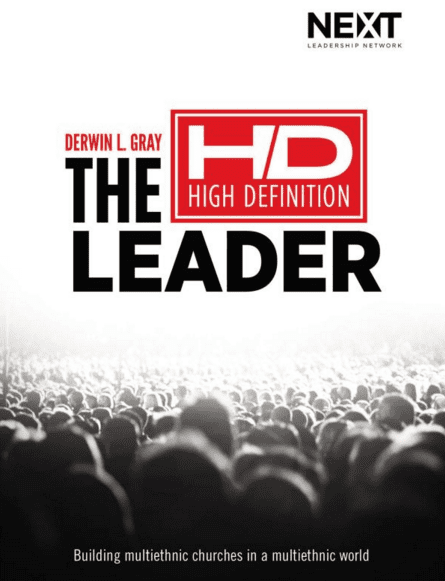 The challenge of this decade and the next can be reduced to one question: Will your church become high-definition or will it remain mono-cultural? The challenge to become multi-ethnic churches requires multi-ethnic leaders, or what Derwin Gray calls The High-Definition Leader. I totally agree with him, and I wonder how many see the problem and want to be part of the solution? [This is one of the Jesus Creed Books of the Year.]
The challenge of this decade and the next can be reduced to one question: Will your church become high-definition or will it remain mono-cultural? The challenge to become multi-ethnic churches requires multi-ethnic leaders, or what Derwin Gray calls The High-Definition Leader. I totally agree with him, and I wonder how many see the problem and want to be part of the solution? [This is one of the Jesus Creed Books of the Year.]
I have only one question: How diverse is your church? (Or, How diverse is your love for others?) One of the most gospel-drenched measures of “success” in a church is making the invisible visible, or putting on display the reality of demographic diversity by finding demographic unity in the church.
This fact in the Bible remains solid: the final kingdom of God will be an exhibition of a high-definition reality. God’s people is not restricted by race, by ethnicity, by economic status or by educational achievements. The final kingdom of God is for all and will be a magnificent display of the reach of God’s graces.
In 1960, the population of the United States was 85 percent white; by 2060, it will be only 43 percent.2 The face of America is no longer just black and white, like those old televisions from back in the day. America is in high definition now, filled with different colored people. America is now a beautiful mosaic that includes Asian and Latino brothers and sisters.
I know this to be true from personal experience; my wife is a white girl from rural Montana, and I’m a black guy from urban San Antonio, Texas. We have two stunningly beautiful children. When our children are asked to fill out an ethnicity questionnaire, they write, “We are first children of God who happen to have a black father and a white mother (2).
Homogenous church — that’s the USA tradition and it’s the USA temptation. But homogenous churches have an impact, so notice these words from Derwin:
Homogeneous local churches can perpetuate sins like racism. When you are only around your tribe or your own kind, you don’ have to interact with other ethnicities, so your potential racist attitudes go unchallenged. Homogeneous local churches can perpetuate the sin of classism and inequality. When we choose to be with people of our socioeconomic tribe, we can become callous and dismissive of the plight of others. Homogeneous local churches can perpetuate the sin of systemic injustice. If we know only people like ourselves, our hearts shrink and concerns for others and their struggles never teach us to carry one another’s burdens. Homogeneous local churches can perpetuate the sin of economic injustice. We must shift from “Let’s help the poor” to “Let’s be among the poor and do life with the poor.” There is a great opportunity for mutual and beneficial exchanges to take place. When we stay segregated and separated, we find ourselves as Christians living in different worlds even though we may be right next door to one another. (6-7).
Some more reality about churches in the USA:
Marinate on this sad reality: only 13.7 percent of churches in America are multiethnic. This means that 86.3 percent churches are homogeneous. And here’s more to be sad about: churches are ten times more segregated than the neighborhoods they are in and twenty times more segregated than the nearby schools.
Our neighborhoods are ethnically diverse, but the local church, which is supposed to exist as a community of God’s reconciliation, is not. Our public schools are ethnically diverse, but the local church, which is supposed to exist as a display of God’s love for all people, is not. Our military is multiethnic, but the local church, which exists as a showcase of Jesus’ unifying power, is not. Our nightclubs are ethnically diverse, but the local church, which exists as God’s new humanity brought into being through life, death, resurrection, and ascension of Jesus, is not.
Doesn’t this seem hypocritical and beneath the gospel? Doesn’t this seem shallow and a mere shadow of the early church? (15-16)
What we need is not more chatter but more high-definition leaders working toward high-definition leadership and high-definition churches with churches filled with high-definition Christians:
We need high-definition leaders who can lead the church into America’s multicolored future. Just as high-definition television allows one to see colors vividly, clearly, and beautifully, we need church leaders who can build multicolored local churches through the Spirit’s power so America can clearly see God’s character vividly, clearly, and beautifully through his diverse people.
A high-definition leader is a leader who is so passionate about the glory of God being revealed through the local church that he or she is willing to learn how to be a cross-cultural, gospel-of-grace preaching, organizational-strategizing, leader-developing disciple of people who partners with the Lord Jesus in building local churches that reflect the future of the church in the present. (See Revelation 5:9-12.) (17).











